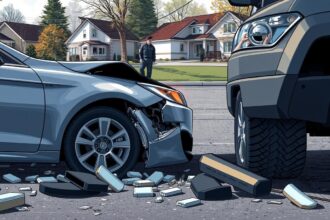What Is a Compact Car – Vehicle Size Guide for Buyers
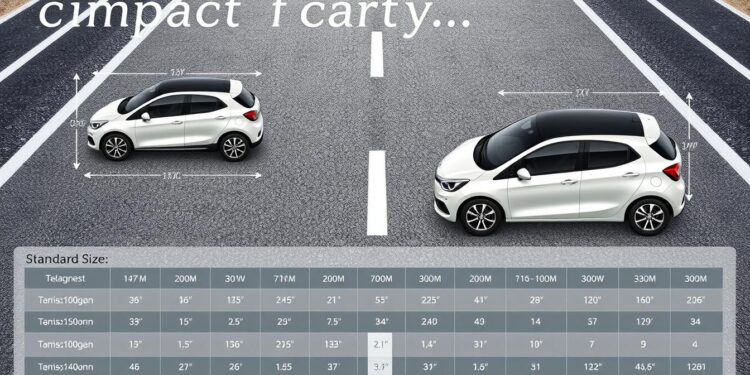
Compact cars are a smart choice for city drivers. They are small, making them perfect for tight city streets. The market offers many options that are affordable, efficient, and easy to handle.
Knowing what a compact car is more than just size. They offer great comfort inside and are easy to park. Models like the Honda Fit and Kia Soul have become stylish and tech-savvy.
These cars are also great for saving fuel. They get 25 to 35 miles per gallon in the city. This means less money spent on gas and better for the environment.
Table of Contents
- 1 Understanding Vehicle Classifications and Sizes
- 2 What is a Compact Car
- 3 Dimensions and Specifications of Compact Cars
- 4 Benefits of Owning a Compact Car
- 5 Popular Compact Car Models and Manufacturers
- 6 Fuel Efficiency and Environmental Impact
- 7 Compact Cars vs Subcompact Cars
- 8 Safety Features in Modern Compact Cars
- 9 Compact Car Performance and Handling
- 10 Interior Comfort and Technology Features
- 11 Comparing Compact Cars to Midsize Vehicles
- 12 Maintenance and Operating Costs
- 13 Ideal Uses and Target Market
- 14 Common Misconceptions About Compact Cars
- 15 Conclusion
Key Takeaways
- Compact cars typically measure less than 14 feet in length
- Offer superior fuel efficiency compared to larger vehicle categories
- Ideal for urban driving and tight parking spaces
- Provide cost-effective transportation options
- Feature modern design and advanced technology
Understanding Vehicle Classifications and Sizes
Vehicle classifications help us understand the many car options out there. The car industry uses specific standards to group cars. This way, buyers know what they’re getting. Each size, from small to large, shows what a car can do and how it’s made.
Different Car Size Categories
Car sizes vary, each with its own features. The main groups are:
- Microcar (smallest vehicle type)
- City car (perfect for city living)
- Subcompact
- Compact car
- Midsize
- Full-size
Industry Standard Measurements
The U.S. Environmental Protection Agency (EPA) sets clear rules for car sizes. A fuel-efficient car, like a compact, usually has:
| Classification | Interior Volume | Length Range |
|---|---|---|
| Subcompact | 85-99 cubic feet | 157-165 inches |
| Compact Car | 100-109 cubic feet | 161-187 inches |
| Midsize | 110-120 cubic feet | Up to 196.8 inches |
Vehicle Classification Systems
Each region has its own way of classifying cars. In Japan, city cars must meet strict size rules. In Europe, letters are used to group cars. In the U.S., it’s all about interior space and length.
“Understanding vehicle classifications helps consumers make informed purchasing decisions.” – Automotive Experts
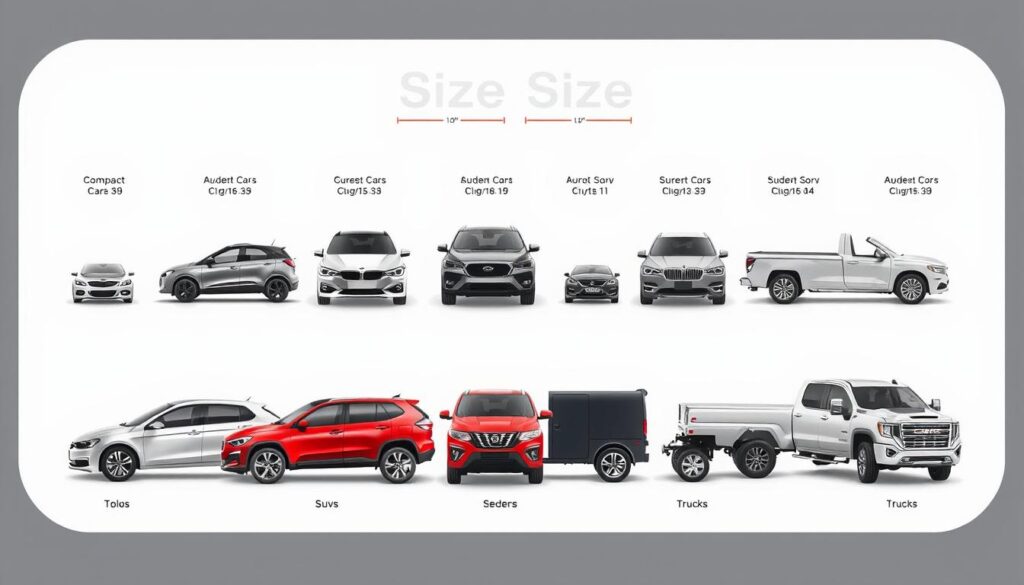
For city folks, a compact car is perfect. It’s small, efficient, and easy to park. These cars are great for city driving, saving fuel and space.
What is a Compact Car
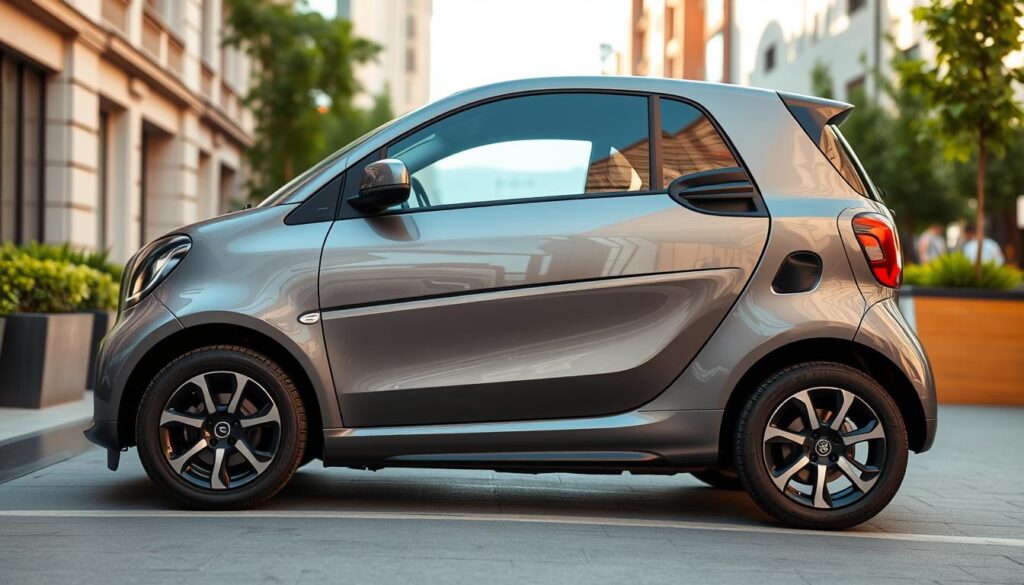
A compact car is a smart choice for city drivers and those watching their budget. They are between 10-14 feet long and 5.8-6 feet wide. This size makes them both useful and affordable.
Compact cars have two main types:
- Sedan: A classic four-door car with a separate trunk
- Hatchback: A car with a rear door that opens up, giving more room for cargo
The EPA says compact cars have an interior volume of 100–109 cubic feet. This size became popular in the 1950s. People wanted smaller, cheaper cars back then.
“Compact cars revolutionized personal transportation by combining efficiency with comfort.” – Automotive History Journal
During tough times, like the 1958 Recession and 1973 Energy Crisis, people wanted cars that saved fuel. American Motors made compact cars that were both affordable and appealing.
Today’s compact cars have great features:
- They can get up to 40 mpg on the highway
- They start at low prices, around $20,000
- They come with the latest tech
- They’re great for moving around the city
Today, compact cars are a wise choice for those looking for affordable, practical cars without losing out on style or performance.
Dimensions and Specifications of Compact Cars
Compact cars are perfect for those looking for an affordable car with good size. They offer a great mix of comfort inside and efficiency outside. This makes them a hit with city folks and those watching their budget.
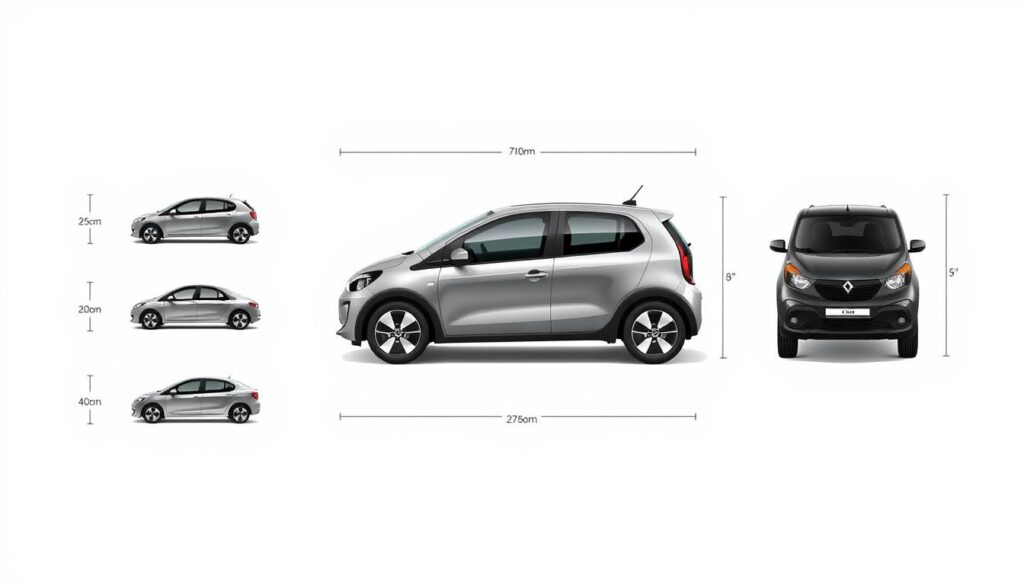
Length and Width Measurements
Compact cars come in a variety of sizes, making them both useful and easy to handle. They are usually between 161 to 187 inches long and 65 to 71 inches wide. This size is perfect for navigating through crowded city streets while keeping the inside roomy.
- Typical length: 161-187 inches
- Standard width: 65-71 inches
- Height range: 4.5-5 feet
Interior Space Considerations
Even though they are smaller, compact cars are made to use space well. Most models can fit up to 5 people, making them great for families and commuters.
| Feature | Specification |
|---|---|
| Passenger Capacity | 5 people |
| Door Configuration | 4 doors |
| Average Fuel Economy | Up to 39 miles per gallon |
Trunk Capacity Guidelines
The trunk of a compact car is surprisingly big, perfect for daily needs and weekend trips. While sizes differ, most can hold groceries, luggage, and more.
“Compact cars prove that great things come in small packages” – Automotive Design Expert
These cars keep getting better, with smarter designs and features. They meet the needs of today’s drivers who want efficiency and practicality.
Benefits of Owning a Compact Car
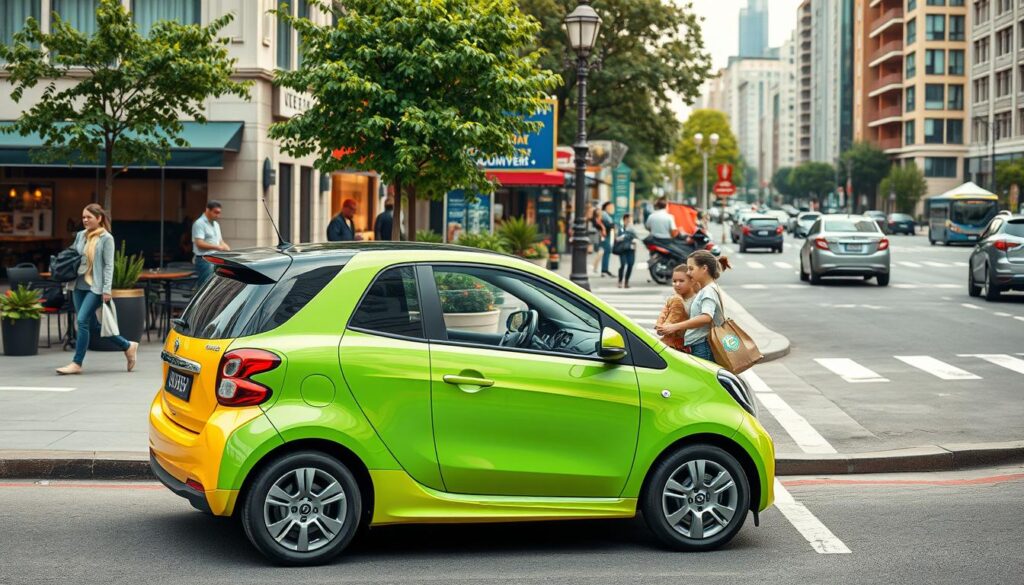
Compact cars are a smart choice for today’s drivers. They are efficient and practical. These cars are great for city living and saving money.
The main perks of owning a compact car include:
- Exceptional fuel efficiency with up to 40 MPG on highways
- Lower insurance premiums
- Reduced maintenance costs
- Easy maneuverability in tight urban spaces
- Environmentally friendly driving option
Driving an eco-friendly car saves money. Insurance for compact cars is 10% to 30% cheaper than big vehicles. Repair costs are also 15% to 20% lower than SUVs and trucks.
“Compact cars represent the perfect balance between affordability, efficiency, and practicality for modern drivers.”
Drivers get big economic benefits. Compact cars make up about 20% of U.S. sales. They can seat 4-5 people and have about 100-109 cubic feet of space inside.
| Benefit Category | Percentage Savings |
|---|---|
| Insurance Premiums | 10-30% |
| Repair Costs | 15-20% |
| Fuel Efficiency | 30-40 MPG |
Compact cars keep getting better, meeting the needs of eco-friendly and budget-conscious drivers.
Popular Compact Car Models and Manufacturers
The compact car market is full of exciting options for city drivers. These cars are efficient, affordable, and offer great value. They strike a perfect balance between performance, comfort, and price.
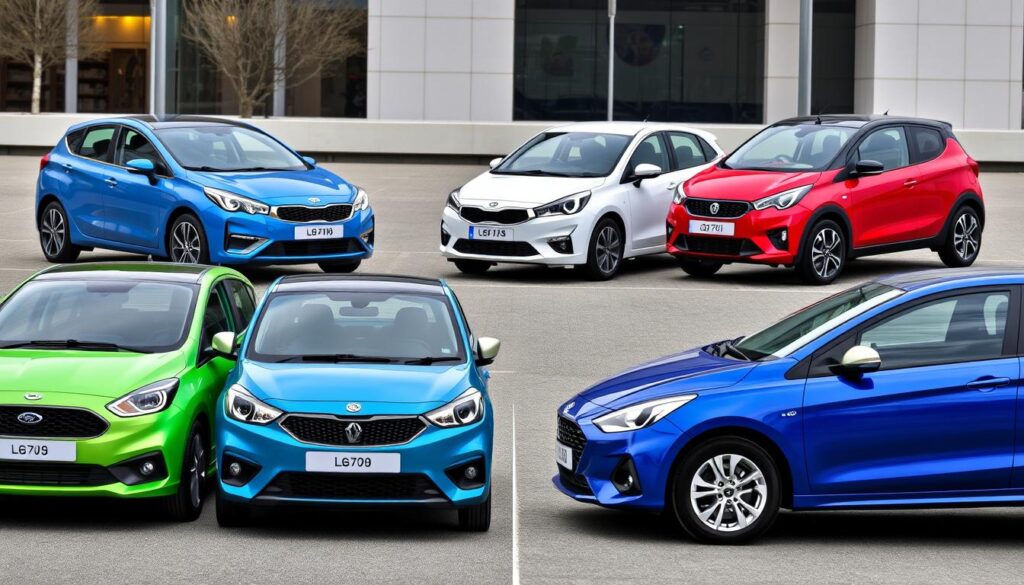
Many manufacturers have made a mark in the compact car world. They offer models that cater to different needs and preferences.
Leading Compact Car Brands
- Honda (Civic)
- Nissan (Versa)
- Hyundai (Elantra)
- Toyota (Corolla)
- Mazda (Mazda3)
Best-Selling Models
The Acura Integra is a standout in the compact car market. In 2023, it won the North American Car of the Year Award. It even outsold the Audi A3 and BMW 228i GranCoupe.
Price Range Comparison
Compact cars are very affordable, with prices from $8,998 to $50,998. The Acura Integra offers great value with its features:
- Standard model: Turbocharged 1.5-liter engine (200 horsepower)
- Type S model: Turbocharged 2.0-liter engine (320 horsepower)
- Unique six-speed manual transmission
“Compact cars represent the perfect blend of efficiency, affordability, and urban mobility.” – Automotive Experts
These cars also offer excellent fuel economy. They get between 23 to 34 MPG. This makes them a smart choice for daily driving.
Fuel Efficiency and Environmental Impact
Compact cars are leading the way in fuel efficiency and caring for the environment. They help cut down on carbon emissions and lessen harm to our planet. With fuel economy ratings of 28-36 miles per gallon, they are a wise pick for those who care about the earth.
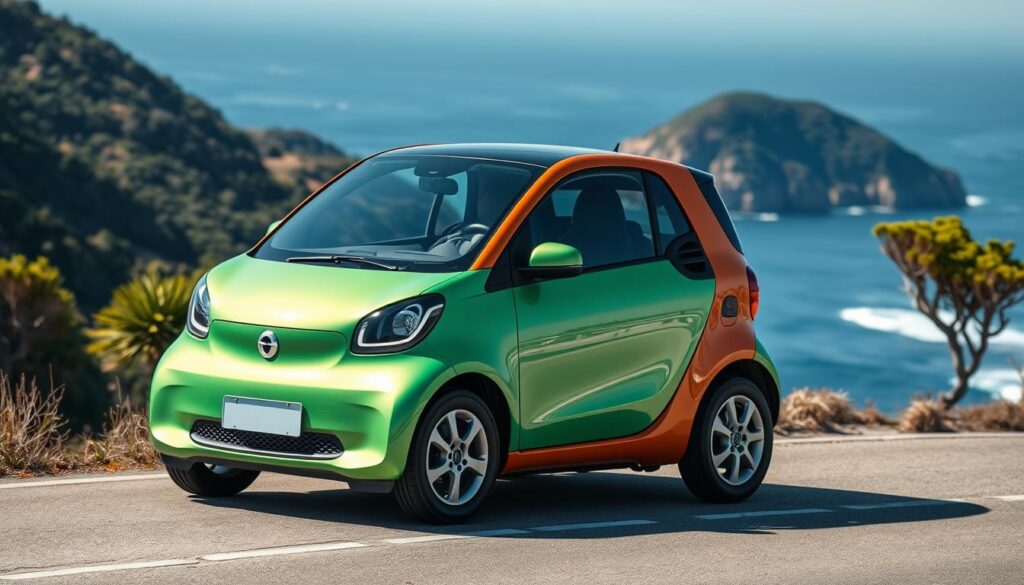
- Lower greenhouse gas emissions
- Reduced fuel consumption
- Smaller carbon footprint
- Enhanced urban air quality
Today’s cars are more than just gasoline-powered. Hybrid and electric compact cars are changing how we think about driving. The rise in electric vehicle sales shows we’re moving towards a greener future.
| Vehicle Type | Average MPG | Annual Fuel Cost | GreenScore |
|---|---|---|---|
| Toyota Prius Prime SE | 133 | $529 | 71 |
| Nissan Leaf | 112 | $741 | 66 |
| Hyundai Kona Electric | 120 | $695 | 63 |
Choosing a compact car is more than a personal choice—it’s a statement for the planet. By picking a fuel-efficient car, drivers help lower pollution and support green transportation.
Smaller vehicles, bigger environmental impact: Choose wisely, drive responsibly.
Compact Cars vs Subcompact Cars
Finding the right small car can be tough. It’s easy to get confused between compact and subcompact cars. Knowing the differences helps buyers make better choices.
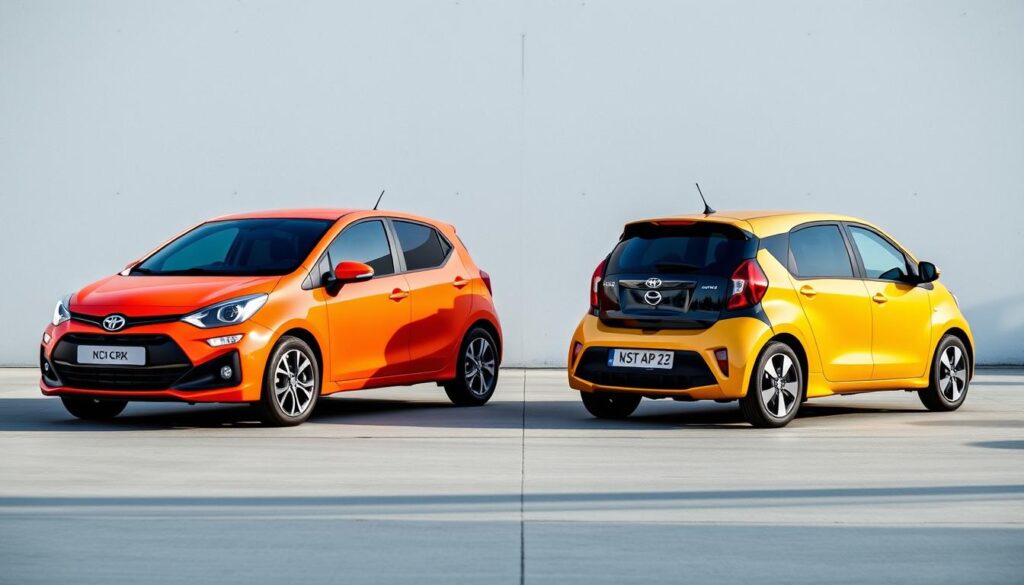
Size Differences
Subcompact cars are the smallest type of car. They have a total space of 85-99 cubic feet. They are shorter and narrower, perfect for city driving.
- Subcompact cars: Under 13 feet in length
- Compact cars: Slightly larger, typically 14-15 feet long
- Interior space: Subcompact cars offer more limited cabin room
Performance Comparison
Subcompact cars may be small, but they pack a punch. They are fuel-efficient and easy to handle. Their light weight makes them great for city driving.
Price Point Variations
Price is a big difference between compact and subcompact cars. Subcompact cars are cheaper to buy. The market has seen interesting trends, with subcompact car sales experiencing significant fluctuations.
“Small cars, big value” – A common saying among automotive enthusiasts
The subcompact car market has changed a lot. In the mid-2000s, they were the fastest-growing cars in the U.S. By 2008, the Toyota Yaris saw a 46% sales increase, showing their popularity.
Choosing between a compact and subcompact car depends on what you need and like.
Safety Features in Modern Compact Cars
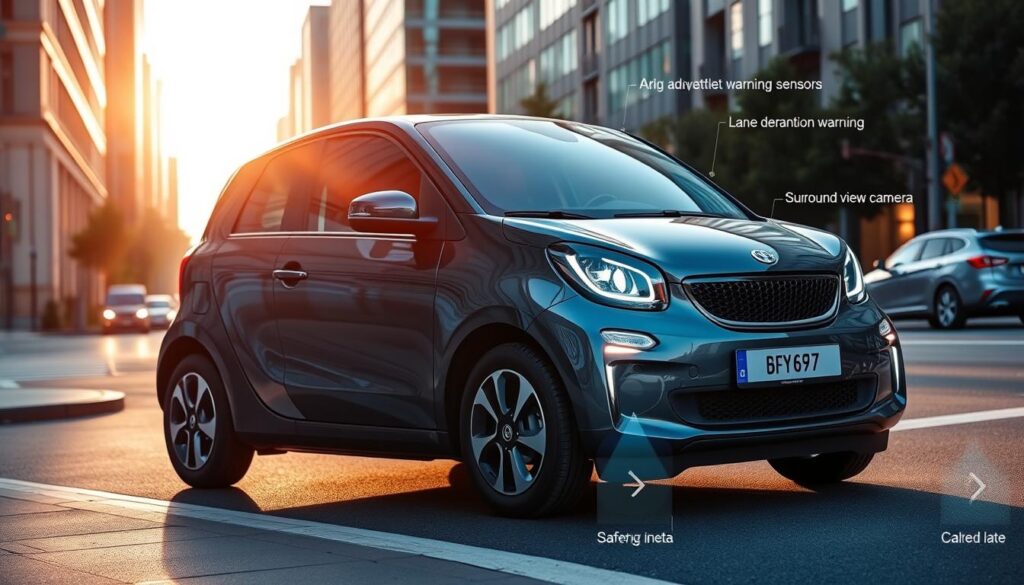
Safety is a top concern for those looking into compact cars. Today’s compact cars have made huge strides in safety thanks to new tech. They offer safety features that were once only found in bigger, pricier cars.
These smaller cars now come with advanced safety tech. This tech is designed to keep drivers and passengers safe.
- Forward Collision Warning Systems
- Automatic Emergency Braking
- Lane Departure Warnings
- Adaptive Cruise Control
- Blind Spot Monitoring
The Insurance Institute of Highway Safety (IIHS) has done important research on compact car safety. They found that even though smaller cars used to be riskier, new designs and tech have greatly improved safety.
“Safety is no longer about size, but about intelligent engineering and advanced technology.” – Automotive Safety Expert
Recent crash tests show big improvements in compact car safety. The Volkswagen Golf and Nissan Leaf stand out, with very low death rates compared to others in their class.
| Safety Feature | Typical Availability | Cost Impact |
|---|---|---|
| Collision Alert | Standard on 70% of Models | Minimal Price Increase |
| Lane Keeping Assist | Available on 55% of Models | Moderate Price Addition |
| Automatic Braking | Standard on 45% of Models | Significant Safety Enhancement |
When choosing an economical car, look for cars with lots of safety features. Remember, you can find cars with great safety at different price points.
Compact Car Performance and Handling
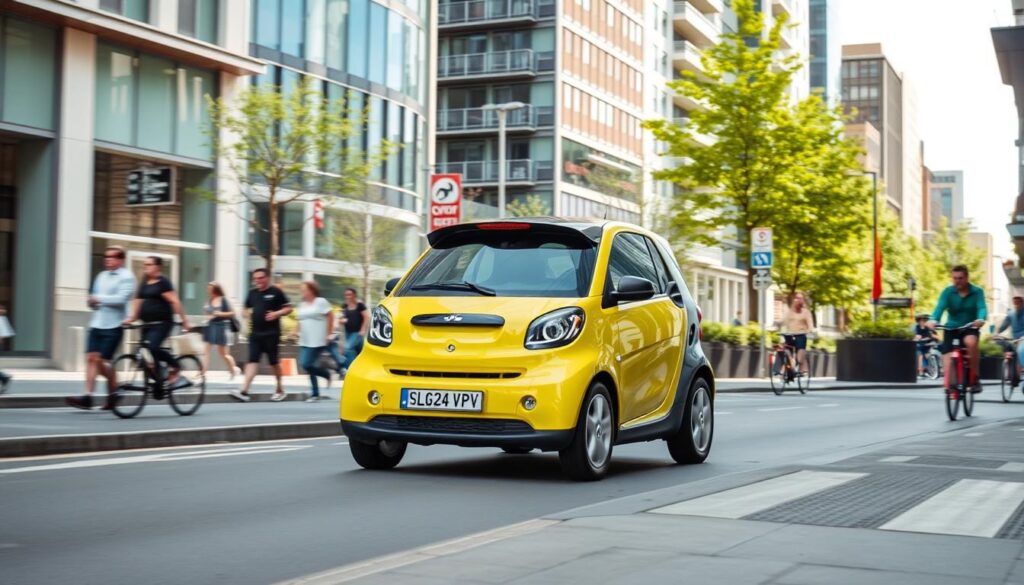
Compact cars are great for city driving. They are easy to maneuver and drive well. They also save fuel, making them practical and efficient.
The performance of a city car depends on a few things:
- Engine efficiency
- Transmission responsiveness
- Suspension design
- Weight distribution
Today’s compact cars are made to handle well in the city. They are designed to be agile and easy to control, even in tight spots.
“Compact cars transform city driving from a challenge into an enjoyable experience” – Automotive Performance Magazine
Engine choices have changed a lot. Many cars now have turbocharged engines. These engines give more power but don’t use more fuel. For example, the Mazda3 has a turbocharged engine that makes it fun to drive.
Here are some key performance features for compact cars:
- Quick acceleration in urban settings
- Tight turning radius
- Responsive steering
- Efficient braking systems
Modern cars also have advanced safety features. These features make driving safer and more enjoyable.
Interior Comfort and Technology Features
Compact cars have changed a lot. They’re no longer just simple cars. Now, they’re smart, feature-rich vehicles.
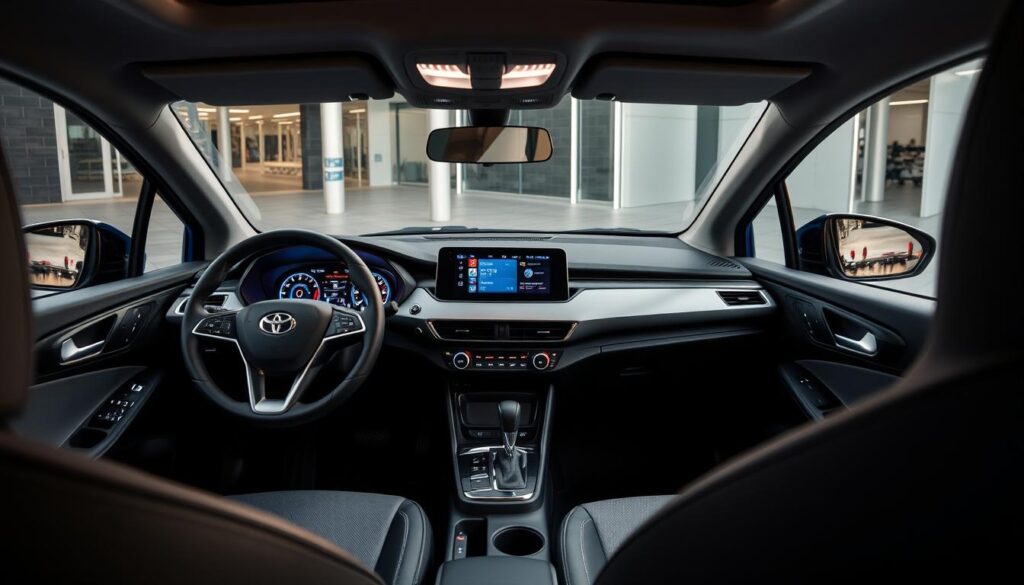
Today’s compact cars have amazing interior features. They rival bigger cars in comfort and tech. Designers have made them spacious and tech-savvy.
Cabin Space Optimization
Designers have mastered making compact cars roomy. They use smart seat designs and layouts. This makes the car feel bigger.
- Intelligent seat configurations
- Slim-profile seat designs
- Ergonomic layouts that create spacious feels
- Flexible cargo management systems
Modern Tech Integration
Technology is key in compact cars. Most come with:
- 8-10 inch touchscreen displays
- Apple CarPlay and Android Auto compatibility
- Advanced voice recognition systems
- Wireless charging capabilities
Comfort Features
Compact cars now have luxury features. They offer:
| Comfort Feature | Availability |
|---|---|
| Heated Front Seats | Standard in most trims |
| Leather Upholstery | Available in top-end models |
| Dual-Zone Climate Control | Common in newer models |
| Panoramic Sunroof | Optional in select models |
“Compact cars have evolved from basic transportation to tech-savvy, comfort-rich vehicles that meet diverse consumer needs.” – Automotive Design Expert
These changes show compact cars are more than just basic cars. They’re now tech-savvy, comfortable, and great value.
Comparing Compact Cars to Midsize Vehicles
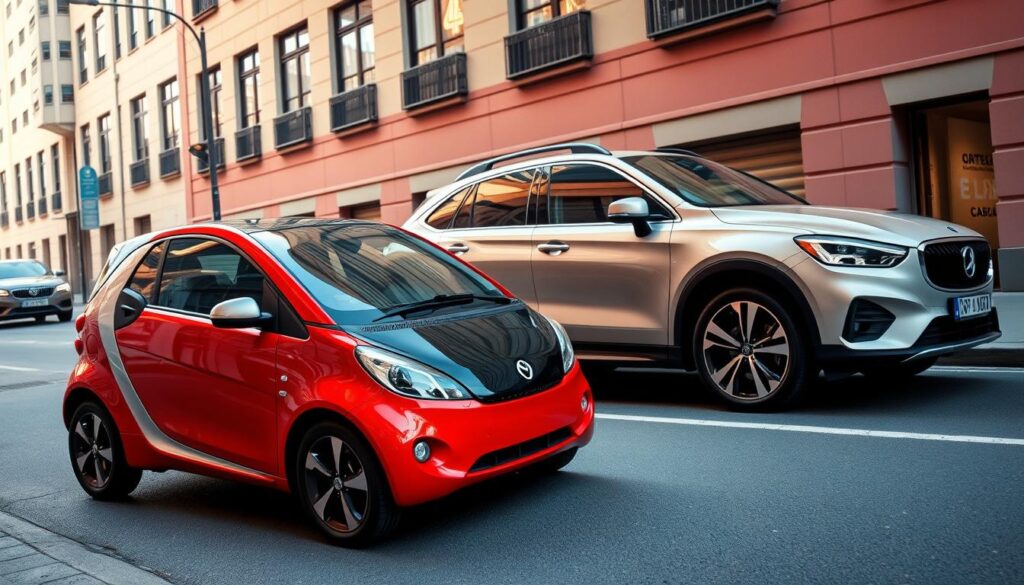
Choosing between a small car and a sedan is a big decision. It affects how you drive. Compact sedans and midsize vehicles have their own benefits for different lifestyles.
Here are the main differences:
- Interior Space: Compact sedans have 100-109 cubic feet of space. Midsize sedans offer 110-120 cubic feet.
- Length: Compact sedans are 161 to 187 inches long. Midsize sedans can be up to 196.8 inches long.
- Fuel Efficiency: Compact cars usually get better gas mileage.
- Price: Small cars are more affordable.
City drivers love compact sedans for their exceptional maneuverability. They fit well in tight spaces, making parking and driving easier. Models like the Chevrolet Cruze and Hyundai Elantra are popular for this reason.
Compact cars offer a great mix of affordability, efficiency, and practicality for today’s drivers.
Midsize sedans are better for other needs. They have more room, comfort, and stability. For families or those who travel a lot, the Ford Fusion might be a better choice.
| Feature | Compact Sedan | Midsize Sedan |
|---|---|---|
| Interior Space | 100-109 cu ft | 110-120 cu ft |
| Length | 161-187 inches | Up to 196.8 inches |
| Average Price | Lower | Higher |
Choosing between a small car and a midsize sedan depends on what you value most. Think about where you drive, how many passengers you need to carry, and your budget.
Maintenance and Operating Costs
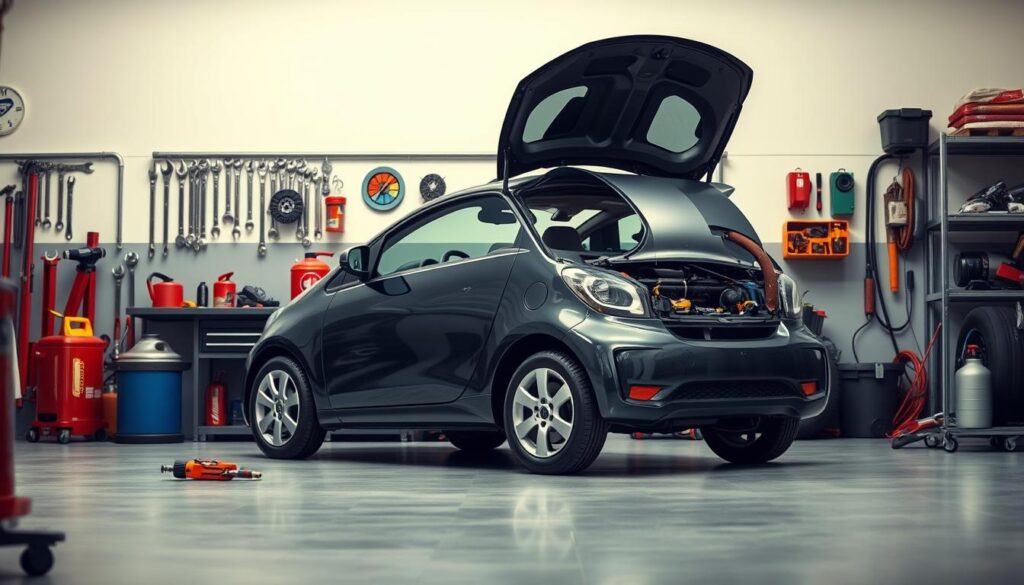
Driving an economical car saves a lot of money. Compact cars are a great choice for those on a budget. They have low maintenance and operating costs compared to bigger cars.
Keeping a compact car running costs less than other cars. You’ll spend less on regular upkeep and unexpected fixes.
Key Maintenance Cost Insights
- Average annual maintenance costs range from $1,100 to $1,450
- Routine oil changes cost between $35 and $125
- Tire rotations average $60 to $72
- Brake pad replacements range from $150 to $300 per axle
10-Year Maintenance Cost Comparison
| Brand | 10-Year Cost |
|---|---|
| Toyota | $5,445 |
| Honda | $6,684 |
| Ford | $10,640 |
A fuel-efficient car saves money in the long run. Compact cars cost about 59.59 cents per mile. Larger cars can cost over 80 cents per mile.
“Choosing a compact car is a smart financial decision for budget-conscious drivers.” – Auto Experts Magazine
Choosing an economical car helps keep your transportation costs down. You get reliable transportation without breaking the bank.
Ideal Uses and Target Market
Compact cars are now a key choice for people wanting easy and smart ways to get around. The world is seeing more of these cars, mainly in cities.
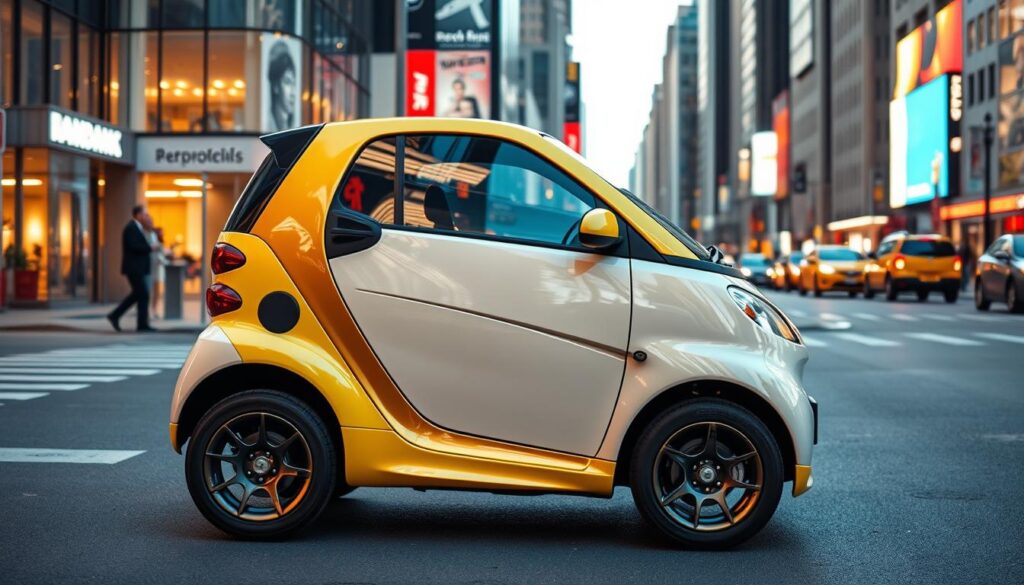
Car makers are making more compact cars to fit what people need and want. These cars are smart for many different lifestyles and are good for the planet.
Urban Commuting Benefits
People love compact cars for how easy they are to drive and park. They offer big benefits like:
- They’re great in tight city streets
- They’re easy to park
- They use less fuel
- They turn easily
Family Suitability
Compact cars are surprisingly good for small families. They have lots of room inside but are small outside. Most have:
- Room for 4-5 people
- Enough space for stuff
- Good safety features
- They’re cheap to keep up
Lifestyle Considerations
The market for compact cars is growing fast, in places like Western Europe, Japan, and North America. These cars are great for people who care about the environment and want a car that’s good for the planet.
“Compact cars represent the perfect intersection of efficiency, affordability, and modern automotive technology.” – Automotive Insights Magazine
As the world moves toward smaller, more efficient cars, compact cars are becoming more popular. They’re a great choice for many people.
Common Misconceptions About Compact Cars
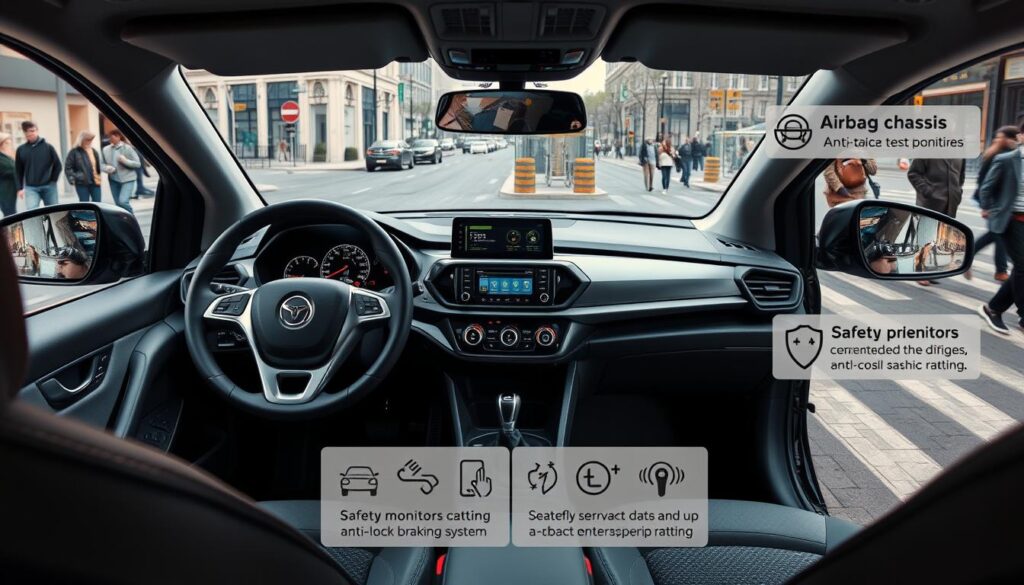
Many people think compact cars are not good. They believe these cars are not safe or powerful. But, these ideas are not true. Let’s clear up some common myths about compact and subcompact cars.
“Size isn’t everything when it comes to automotive safety and performance.” – Automotive Safety Expert
One big myth is that compact cars are not safe. But, modern compact cars are much safer now. They have:
- Advanced airbag systems
- Electronic stability control
- Improved crash zone engineering
- Enhanced structural integrity
Studies by the Insurance Institute for Highway Safety (IIHS) show that many compact cars are very safe. In fact, they are as safe as bigger cars.
Another myth is that compact cars are slow and uncomfortable. But, modern engineering has changed this. Today’s compact cars are:
- Efficient with fuel
- Easy to handle
- Full of new tech
- Quick to accelerate
Lastly, people think compact cars are too expensive. But, they are actually very affordable. They cost less to buy and maintain, and they use less fuel than bigger cars.
Conclusion
Compact cars are a smart choice for those who want practicality and efficiency. They are fuel-efficient, with cars like the Honda Civic getting up to 36 miles per gallon. This makes them great for saving money and being kind to the environment.
The market loves compact cars, with values expected to hit £43.28 billion by 2028. They are great because they can carry up to five people and are good for the planet. These cars offer a perfect mix of cost, performance, and being eco-friendly.
Choosing a compact car depends on what you need and your lifestyle. They are perfect for city living, first-time buyers, or anyone wanting to save on car costs. The growth of hybrid and electric options shows these cars are adapting to new needs and green goals.
Think about getting a compact car for your next vehicle. They are not just practical; they are a smart choice for your wallet and the planet. With their efficiency, affordability, and modern features, they are a great investment in your daily life.






